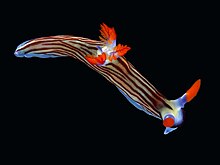

Sea slug is a common name for some marine invertebrates with varying levels of resemblance to terrestrial slugs. Most creatures known as sea slugs are gastropods, i.e. they are sea snails (marine gastropod mollusks) that, over evolutionary time, have either entirely lost their shells or have seemingly lost their shells due to having a significantly reduced or internal shell.[1] The name "sea slug" is often applied to nudibranchs and a paraphyletic set of other marine gastropods without apparent shells.[2]
Sea slugs have an enormous variation in body shape, color, and size. Most are partially translucent. The often bright colors of reef-dwelling species imply that these animals are under constant threat of predators. Still, the color can warn other animals of the sea slug's toxic stinging cells (nematocysts) or offensive taste. Like all gastropods, they have small, razor-sharp teeth called radulas. Most sea slugs have a pair of rhinophores—sensory tentacles used primarily for the sense of smell—on their head, with a small eye at the base of each rhinophore. Many have feathery structures (cerata) on the back, often in a contrasting color, which act as gills. All species of genuine sea slugs have a selected prey animal on which they depend for food, including certain jellyfish, bryozoans, sea anemones, plankton, and other species of sea slugs.[3][4]
Sea slugs have brains. For example, Aplysia californica has a brain of about 20,000 nerve cells.[5]
- ^ Yonow, Nathalie (2015), Rasul, Najeeb M.A.; Stewart, Ian C.F. (eds.), "Sea Slugs: Unexpected Biodiversity and Distribution", The Red Sea: The Formation, Morphology, Oceanography and Environment of a Young Ocean Basin, Springer Earth System Sciences, Berlin, Heidelberg: Springer, pp. 531–550, doi:10.1007/978-3-662-45201-1_30, ISBN 978-3-662-45201-1, retrieved 2024-02-09
- ^ Thompson, T. E. 1976. Biology of opisthobranch molluscs, vol. 1, 207 pp., 21 pls. Ray Society, no. 151.
- ^ Byatt, Andrew; Fothergill, Alastair; Holmes, Martha (2002). The Blue Planet: A Natural History of the Oceans. BBC. DK. ISBN 978-0-7894-8265-5.
- ^ "Sea Slug". encyclopedia.com. Oxford University Press. 18 May 2018.
- ^ Choi, Charles Q. (29 December 2006). "Human, Sea Slug Brains Share Genes for Alzheimer's and Parkinson's". Scientific American.